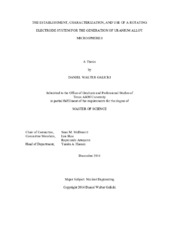| dc.description.abstract | Various proposed metallic nuclear fuel designs for fast reactors may require powder fabrication methods and the reactive nature of uranium metal creates unique challenges. Spherical powder is desired in some fuel concepts over flaky or irregular powder because it will enable predictable packing fractions, even for low density fuels. A previously-established method for powder production is the Rotating Electrode Process (REP) which produces microsphere shaped powder by melting the tip of a rotating cylinder via electric arc. As droplets of molten metal are expelled radially outward, they solidify into spherical particles. A new REP system, named the TAMU Rotating Electrode System (TAMU RES), was developed at Texas A&M University in a previous study. This RES apparatus was placed inside of an inert atmosphere glovebox for this present study to enable uranium powder manufacture. The RES is based on previous designs by Starmet Co. and the Idaho National Laboratory (INL). It is capable of melting a metal rod up to 12.7 cm (5 inches) in length and 1.27 cm (0.5 inches) in diameter as it rotates up to 19,000 RPM. The RES is capable of operating at speeds up to 40,000 RPM provided no mechanical instabilities are present in the rotating cylinder. Varying the RPM alters the diameter of the spheres produced in a predictable fashion, but in a manner that is unique to each material melted by the RES.
The RES is capable of producing repeatable powder size distributions. Copper, depleted uranium (DU), and U-10 wt% Zr (U-10Zr) powders were produced using the RES and their size distributions were characterized as a function of RPM for rotational speeds varying between 10,000 and 19,000 RPM. The copper powders were produced in both air and argon atmospheres, while the uranium and U-10Zr powders were produced under an argon atmosphere to prevent oxidation of the microspheres. Problems and areas of concern like material flaking and rotational instability issues were overcome by the installation of a helium cooling line inside the catch pan, and by selecting mechanically straight rods for melting. Continued characterization work of powders produced by the RES is also addressed. | en |


